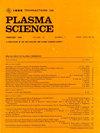Modeling of Thrust Properties for Capillary-Type Pulsed Plasma Thrusters Using Electrothermal Discharge in Teflon
IF 1.3
4区 物理与天体物理
Q3 PHYSICS, FLUIDS & PLASMAS
引用次数: 0
Abstract
Pulsed plasma thrusters (PPTs) are preferred low-power systems for satellites because of their simplicity and small dimensions. This article was carried out to discuss and calculate the basic parameters that describe the efficiency of the electrothermal type of PPTs, using the 1-D time-depending ETFLOW model of the electrothermal capillary discharge with Teflon capillary. Parameters, such as the ablated mass, thrust, impulse, and specific impulse, were calculated. In addition, the basic plasma parameters, such as temperature, pressure, density, velocity, and heat flux, were all studied as a function of discharge time. We also discussed the effect of using an approximation of the transmission heat factor of Teflon. The influences of some input parameters as applied voltage and capillary geometry on thruster parameters were studied. It was found that ablated mass increases with the applied voltage or capillary length and decreases as the capillary diameter increases. Finally, calculations were compared to the measured results of ablated mass, impulse, and specific impulse from different works. The results of our model are in good agreement with experimental results with small variations in impulse and specific impulse values. Variations are expected to be limited if we enter some modifications to the model to increase the exit velocity and use the radial dimension for calculations.聚四氟乙烯电热放电毛细管型脉冲等离子体推力器推力特性建模
脉冲等离子体推力器(PPTs)由于其简单和小尺寸而成为卫星首选的低功率系统。本文利用含聚四氟乙烯毛细管的电热毛细管放电的一维随时间ETFLOW模型,对描述电热型PPTs效率的基本参数进行了讨论和计算。计算了烧蚀质量、推力、冲量和比冲量等参数。此外,还研究了等离子体的温度、压力、密度、速度和热流密度等基本参数随放电时间的变化规律。我们还讨论了采用聚四氟乙烯的近似传热系数的影响。研究了施加电压和毛细管几何等输入参数对推力器参数的影响。烧蚀质量随施加电压或毛细长度的增大而增大,随毛细直径的增大而减小。最后,将计算结果与不同工程的烧蚀质量、冲量和比冲量的实测结果进行了比较。模型计算结果与实验结果吻合较好,冲量和比冲量变化较小。如果我们对模型进行一些修改以增加出口速度并使用径向尺寸进行计算,预计变化将受到限制。
本文章由计算机程序翻译,如有差异,请以英文原文为准。
求助全文
约1分钟内获得全文
求助全文
来源期刊

IEEE Transactions on Plasma Science
物理-物理:流体与等离子体
CiteScore
3.00
自引率
20.00%
发文量
538
审稿时长
3.8 months
期刊介绍:
The scope covers all aspects of the theory and application of plasma science. It includes the following areas: magnetohydrodynamics; thermionics and plasma diodes; basic plasma phenomena; gaseous electronics; microwave/plasma interaction; electron, ion, and plasma sources; space plasmas; intense electron and ion beams; laser-plasma interactions; plasma diagnostics; plasma chemistry and processing; solid-state plasmas; plasma heating; plasma for controlled fusion research; high energy density plasmas; industrial/commercial applications of plasma physics; plasma waves and instabilities; and high power microwave and submillimeter wave generation.
 求助内容:
求助内容: 应助结果提醒方式:
应助结果提醒方式:


